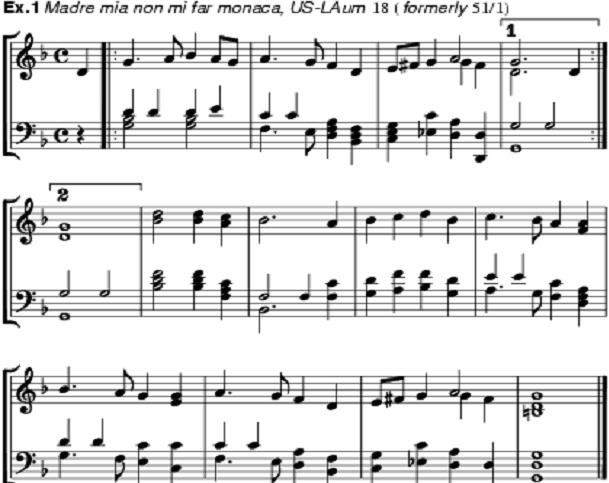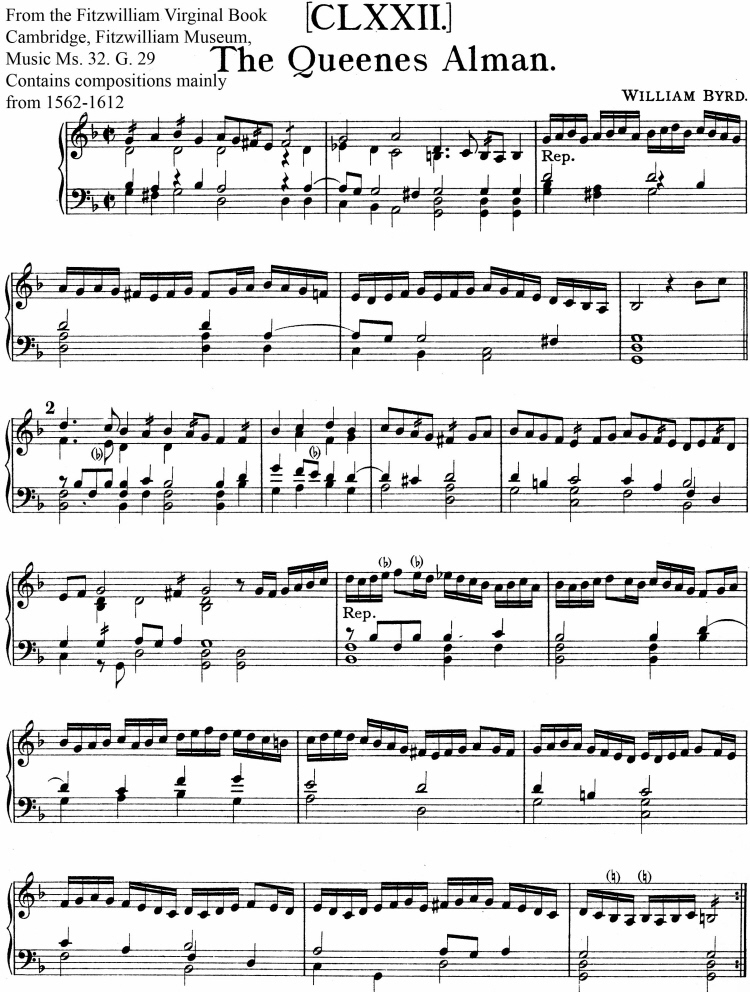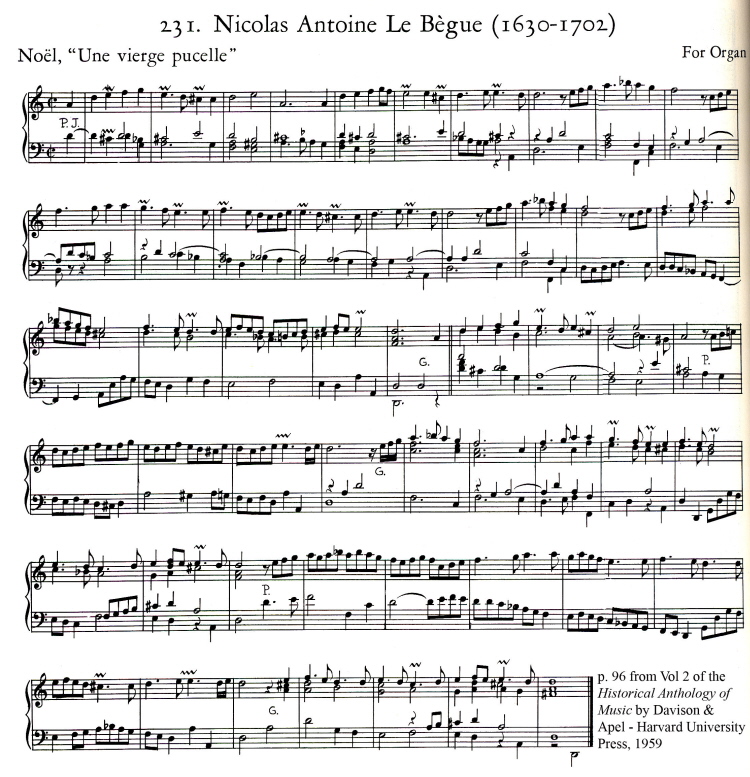|
|
Chorale Melodies used in Bach's Vocal Works
The "Monica" - Historical Background |
|
Monica [monicha, monaca] (It.) was a tune popular in Italy, Germany, France, the Low Countries and England from the 16th century to the 18th. The title stems from the text that was associated with the melody in Italy, Madre non mi far monaca. It tells the story of a young girl forced to become a nun, a recurring theme in much Italian folk literature from the Middle Ages to the Renaissance. |
|
Example 1 |
|

|
|
Ex.1 shows the musical scheme as it appears in an early 17th-century keyboard manuscript. Both tune and text are found in a manuscript collection of Canzonette e madrigaletti spirituali (1610) compiled by Michele Pario ( I-BRq L.IV.99). A variant of this text appeared earlier in a villanella by Antonio Scandello (Il secondo libro dele canzone napolitane , 1577), but the music is unrelated to the monica tune.
The origin of the tune is unknown. However, the terminology adopted in several tablatures of the 16th and early 17th centuries and the occurrence of the monica in dance-like pairs suggest a possible link with the dance-song tradition (Hudson, 1986). In German sources the tune occurs as a Deutscher Tanz, and in Italian, French, Flemish and English sources it is often labelled Alemana, Almande, or Almagne. It also appears as Balo todesco in Gorzanis’s Opera nova de lauto ( c1575–8, 2/1579), as Ballo tedesco et francese in G.A. Terzi’s Intavolatura di liutto (1593), as Balletto Alta Morona in Caroso’s Il ballarino (1581) and as Balletto Celeste Giglio in the revised edition of Caroso’s dance manual ( Nobiltà di dame , 1600). In a group of manuscript guitar tablatures that all seem to descend from the same copyist (I-Fr 2793, 2804, 2849; Fn Lindau Finaly 175, Tn Foà 9) and in I-VEc 1434, however, it is called Aria venetiana or Aria Venetia che cantava Scappino.
The chordal accompaniment for the music appears in numerous 17th-century Italian tablatures for the five-course guitar, beginning with Montesardo’s Nuova Inventione (1606); often two standard riprese or ritornellos are included at the end.
Variations and simple versions of the song for keyboard, for discant and bass and for lute have survived in various manuscripts (Mischiati, 1975; Silbiger, 1980). Frescobaldi composed a set of keyboard variations called Partite sopra la Monicha (Toccate e partite, libro primo , 1615–16). Some scholars have attributed a Missa sopra l’ Aria della monaca (I-Rsg mazzo IX n.8) to him, though this has been disputed (Annibaldi, 1986). Other keyboard variations appear in Bernardo Storace’s Selva di varie compositioni (1664). Biagio Marini wrote a Sonata sopra la monica (1626) for instrumental ensemble.
In France the monica melody circulated with different texts, of which the most popular was Une jeune fillette (the earliest occurrence is the voix de ville in Chardavoine’s Le recueil des plus excellentes chansons , 1576. See: Ex. 2). |
|
Example 2 |
|

|
|
It later achieved popularity as a noël with the text Une jeune (or vierge ) pucelle , a common subject for organ variations in the late 17th century and the 18th. Numerous lute collections published in the Low Countries from the second half of the 16th century introduce the monica tune as Almande nonette. The earliest known piece bearing this title is contained in Phalèse’s Luculentum theatrum musicum (1568), but a Chanson nouvelle de la prinse de Thionville, sur le chant de la Nonette was included in the Recueil des plus belles chansons de ce temps as early as 1559 (See: Ex. 3). |
|
Example 3 |
|

|
|
In Germany the monica was associated with the text Ich ging einmal spazieren and with the chorale Von Gott will ich nicht lassen (Magdeburg, Christliche und tröstliche Tischgesänge , 1572). Settings and elaborations of this hymn may be found in works of Johann Hermann Schein, Samuel Scheidt, Heinrich Schütz, Dietrich Buxtehude and J.S. Bach. The same melody also appears in Lutheran hymn books with the text Helft mir Gottes Güte preisen. Various English instrumental versions of the monica carry the title The Queen’s Almaine or Oulde Almaine, including a variation set by William Byrd ( Fitzwilliam Virginal Book). |
| |
|
Bibliography |
|
L.H. Moe : Dance Music in Printed Italian Lute Tablatures from 1507 to 1611 (diss., Harvard U., 1956), 184–7, 267–9
J.M. Ward: ‘Music for A Handefull of Pleasant Delites’, JAMS, x (1957), 151–80, esp. 175
J. Wendland: La monica: the History of a Migrating Melody (thesis, Duke U., 1974)
O. Mischiati and L.F. Tagliavini, eds.: Girolamo Frescobaldi: Due Messe a otto voci e basso continuo (Milan, 1975)
J. Wendland: ‘“Madre non mi far monaca”: the Biography of a Renaissance Folksong’, AcM , xlviii (1976), 185–204
J. Kurtzman: ‘An Early 17th-Century Manuscript of Canzonette e Madrigaletti’, Studi musicali, viii (1979), 149–71
A. Silbiger: Italian Manuscript Sources of the 17th Century Keyboard Music (Ann Arbor, 1980), 39–44
C. Annibaldi: ‘ Ancora sulle messe attribuite a Frescobaldi: proposta di un profittevole scambio’, Girolamo Frescobaldi nel quarto centenario della nascita , ed. S. Durante and D. Fabris (Florence, 1986), 125–52
R. Hudson: The Allemande, the Balletto and the Tanz, i: The History; ii: The Music, nos.5a, 42, 75, 97, 129 (Cambridge, 1986)
Authors: Richard Hudson/Giuseppe Gerbino, Alexander Silbiger
© Oxford University Press 2006 Accessed 1/19/06 |
| |
|
Additional sources and/or further amplification of sources not listed or given in the Monica article above: |
|
“Ich ging einmal spazieren” is found in Neusidler’s “Teutsch Lautenbuch” (1574) as No. 28.
Another “The Queen’s Alman” is in a setting by “Mr. Daniel” (“Bachelor?”) in Lord Herbert of Cherbury’s lutebook, f. 23v.
The William Byrd composition, “The Queenes Alman” consists of a marvelous set of three beautiful variations. See: Ex. 4, which shows the first of these. |
|
Example 4 |
|

|
|
The French Christmas noëls based upon the Christmas song “Une vierge pucelle” were very popular in 18th century songbooks. There are settings by Nicolas LeBègue (1630-1702) (See: Ex. 5) |
|
Example 5 |
|

|
|
and Louis-Claude Daquin (1694-1772) for organ.
Eustache Du Caurroy (1549-1609) composed a Christmas motet on “Une jeune fillette” (published 1609) in which he displayed great artistry in developing a theme by providing 5 settings/variations with using 3, 4, or 5 voices. The ornamentation changes in each one of these settings. |
| |
|
Contributed by Thomas Braatz (January 2006) |
|
|